Why does my Duolingo icon look sick: a guide to different Duolingo app icons
Why does my Duolingo icon look sick?
That usually energetic green owl Duo suddenly looks like it's "on its deathbed"? Don't panic—it's just another one of its antics!
Opening my phone this morning, I was greeted by Duolingo's new icon showing our once lively mascot transformed into a crumpled, sickly version of itself—eyes drooping into "X" marks like it's about to flatline. This dramatic makeover instantly trended online, with netizens divided:
- "OMG why is this depressed owl so hilariously ugly?"
- "Did Duolingo get hacked or something?"
- "Did Duo literally die waiting for me to do my lessons?"
![]()
Not missing a beat, Duolingo officially issued a mock "obituary," solemnly declaring that "Duo has passed away from heartbreak due to users' prolonged neglect of their lessons." The prescription to revive it? Simple—open the app and study for five minutes right now!
Next time you see Duo "on life support," don't worry—it's just their creative way of nudging you back to your lessons. As someone who's been consistently learning Spanish on Duolingo for two years, I'll take you behind the scenes of this phenomenon. We'll explore Duolingo's unique brand culture, the origins of Duo the Owl, the stories behind characters like Lily and Zari, plus all the viral memes and inside jokes.
Duolingo proves language learning doesn't have to be serious—it can be this much fun! Ready to get hooked by this owl's wild story?
How Was Duolingo's Owl Created?
Did you know? Duo's image wasn't always this cute. From its initial design, it has gone through several changes. It’s these evolving icons that have given us the interesting and unique owl we see today. Let’s take a look at the fascinating stories behind the transformation of these icons.
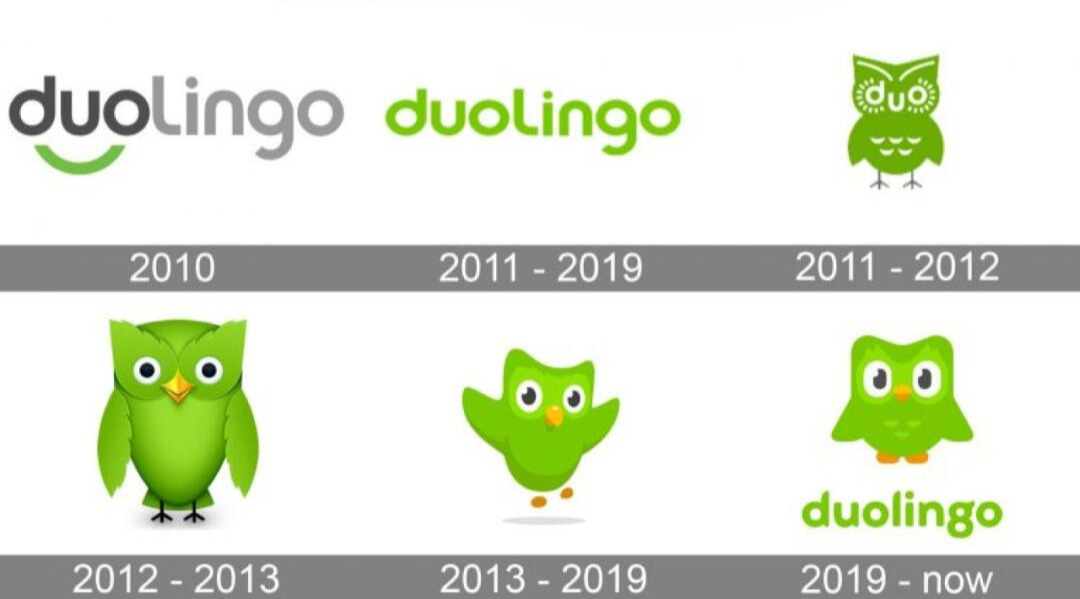
2010: The First Icon - "Duolingo"

The original logo didn't even feature an owl—it was simply a split design of the word "duolingo." The word "duo" was in black, "lingo" in gray, and a curved line was added below the first three letters. The "d" and "o" looked like round eyes, the "u" like a small nose, and the curve turned into a smiling mouth. With this minimalist letter combination, the logo conveyed a "friendly" signal, and it was during this time that the mascot Duo's image began to take shape.
2011: Duo's Birth
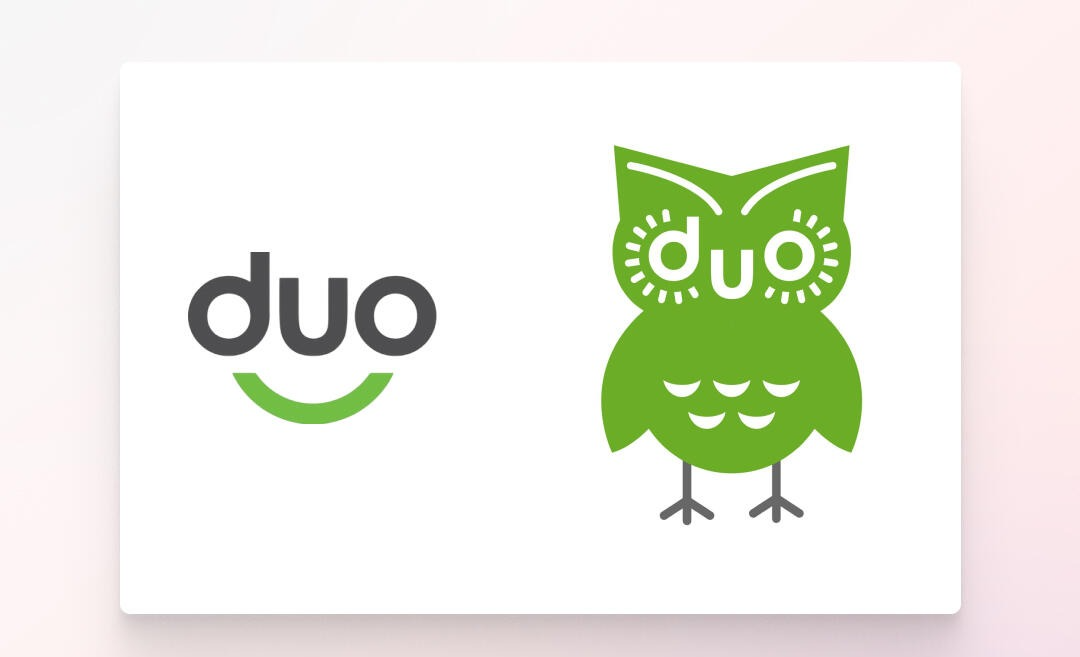
In 2011, Duo made its official debut as an owl. The flat, green body, tiny white decorative accents, and slightly disproportionate black legs were all part of this early version. The letters "d" and "o" served as its eyes, and the "u" was used as the beak. Here's a fun story behind the design: CTO Severin explicitly said, "Don't use green, I hate green," but the CEO Luis went the opposite route and chose green—symbolizing wisdom—and picked an owl as the mascot. This playful, somewhat rebellious decision added a personal touch to the brand.
2012: Duo Goes 3D
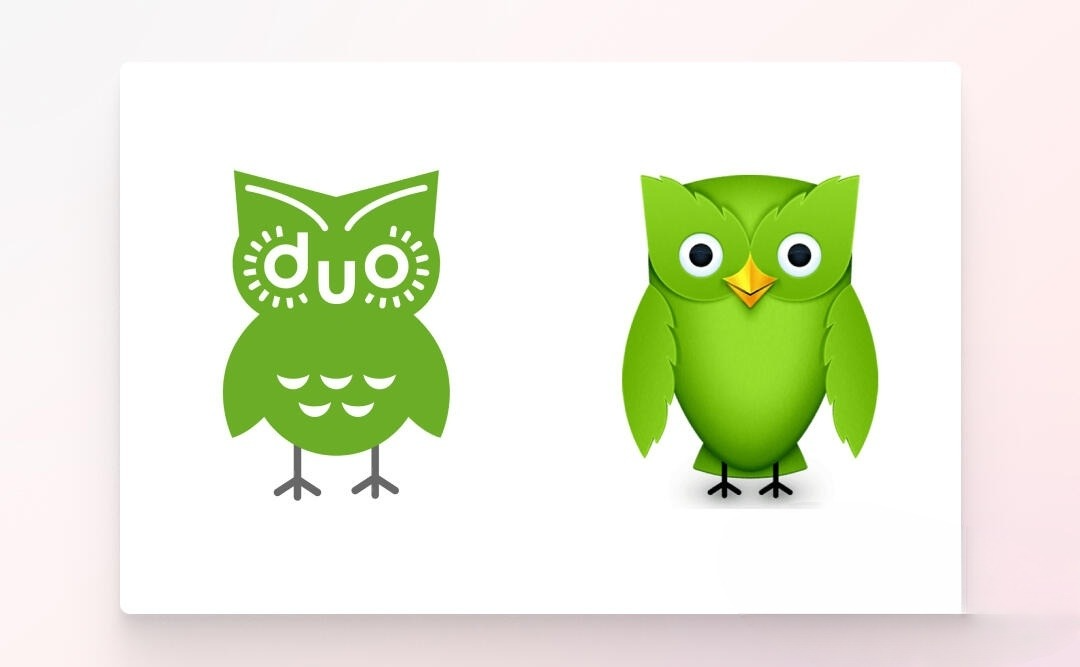
In 2012, the 3D version of Duo became more natural and friendly. The team removed the letter-based facial features, adding a tail and feathered wings, and used a gradient green effect for a 3D appearance. While this version may not be iconic, it marked an important step in the brand’s exploration of "how to make a virtual character more lively."
2013-2019: A Return to Flat Design
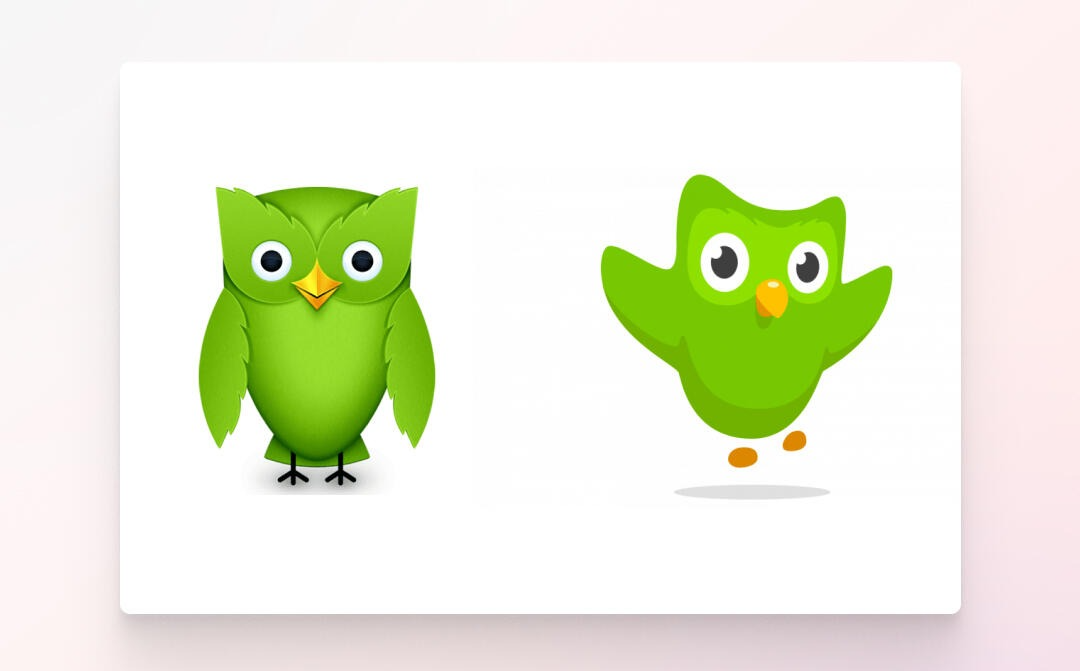
In 2013, Duo returned to a flat design with wings spread wide as if to embrace users. Its bright, sparkling eyes and upright "ears" conveyed warmth, and even its claws were simplified to two yellow dots. This "minimalist" animation style design made Duo feel "friendly" and lovable. The green layering was also cleverly done, maintaining brand recognition while enhancing depth through color gradients. By this time, Duo had evolved from a simple icon into a "study buddy" that encourages you to learn.
2019 - Present: Duo Becomes "Social Currency"
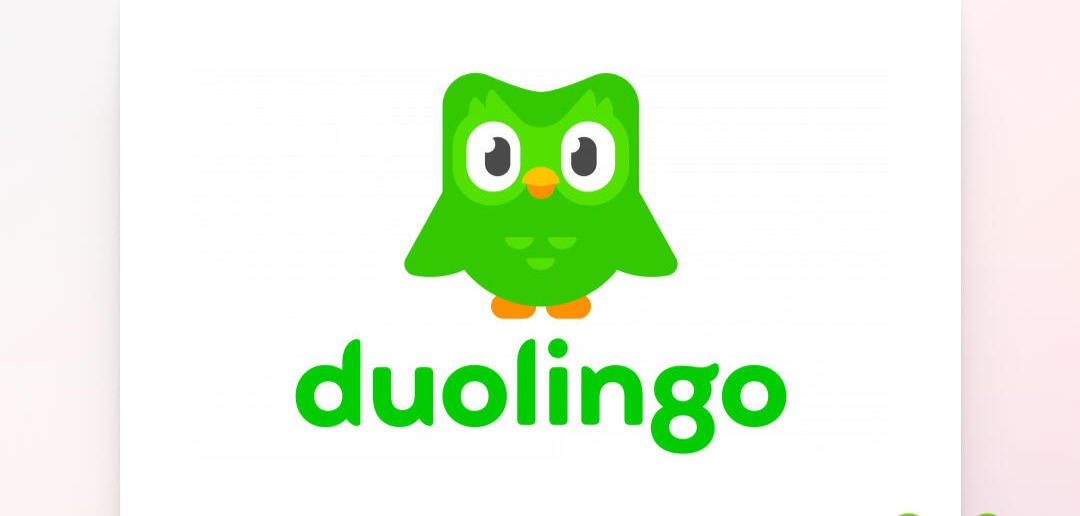
In the 2019 redesign, Duo fully embraced its status as an "internet celebrity." Designers removed the gradients, enlarged the eye fluff, and added three small semicircles on the belly. These simplifications made the icon clearer on small screens. But what really stood out was its "emotional expression." When its wings are raised, it looks happy; when they’re down, it appears sad. The mouth’s movements convey a sense of "urging," "encouraging," and even "threatening." Duo’s emotional range went from gentle encouragement to hilarious outbursts, achieving unparalleled expressiveness. Users started screenshotting and posting on social platforms, joking about the "fear of being stared at by Duo while studying." This self-propagating design turned the icon into a medium for interaction between the brand and its users.
Did You Know? Duolingo App Icon Changes in These Fun Ways!
You might know Duo the owl as your persistent language-learning reminder, but did you know it's also a master of disguise? Every time you open the app, you never know which version of Duo you'll encounter. These little surprises make learning even more engaging! Let’s take a look at some of the most memorable "costume changes":
Personalized Duo Based on User Behavior
Streak Rewards: Unlocking Limited-Edition Duo
In Duolingo, the streak icon evolves as users maintain consecutive days of learning.
Rules
- 1 day streak: Basic green background + standard Duo
- 7 days streak: New icon unlocked
- 30/50/100/365 days streaks: Exclusive designs (e.g., fiery orange Duo)
- 999+ days streak: Legendary status with special effects
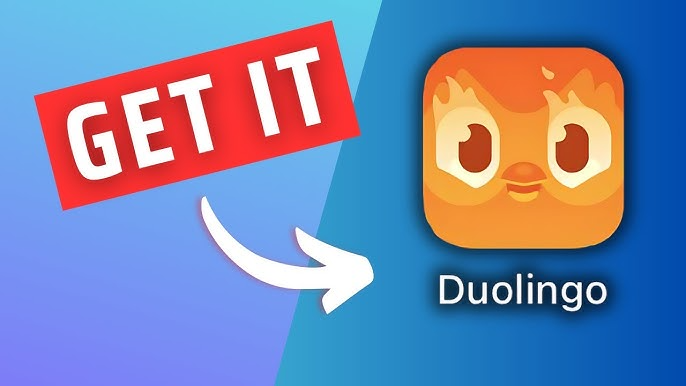
Super Member Exclusive Icon
Features: A sleek blue owl, reinforcing the identity of premium users.
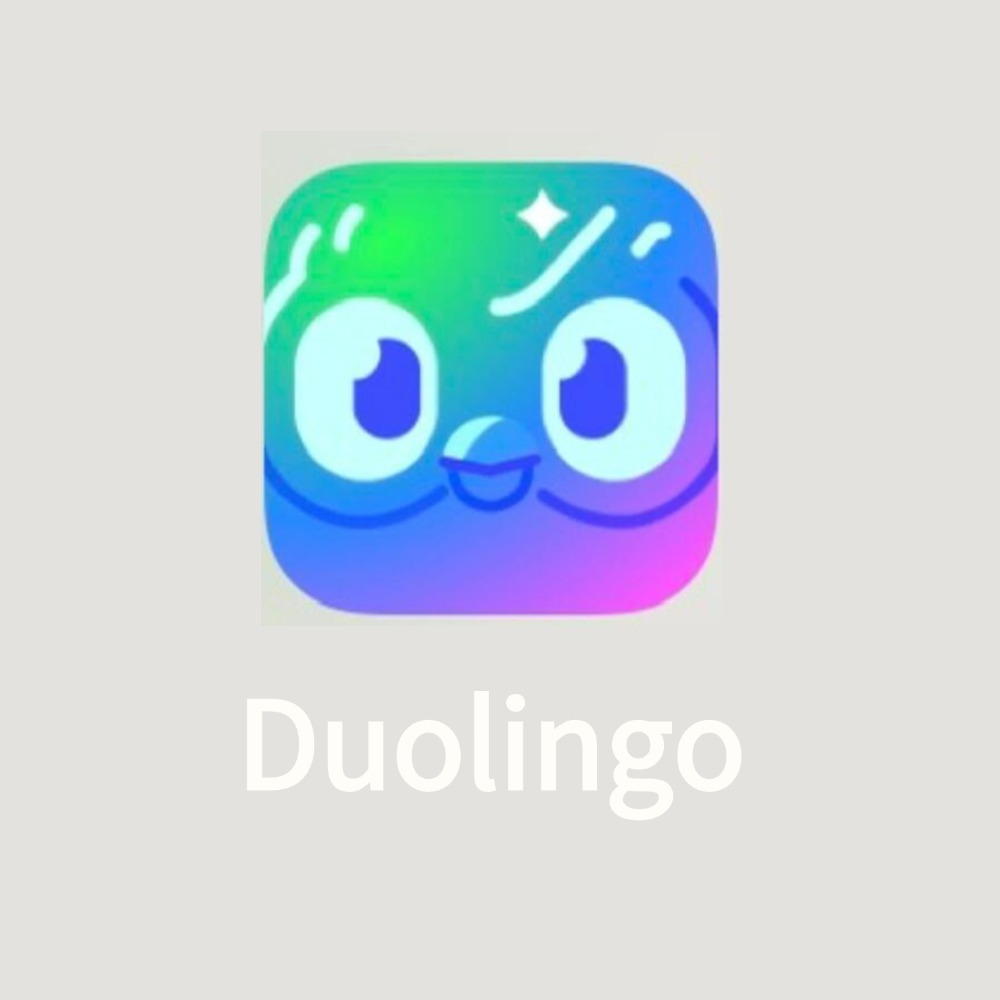
Customization Options
How to access:
Tap the "flame" or "streak" icon in the app → Select "Change Icon"
Options: 5-10 different icons, some requiring achievements (e.g., 100-day streak)
Limited-Edition Duo for Marketing & Holidays
Melting Duo (October 2023)

Duo appeared as a puddle of "melted" goo, looking utterly defeated—like an ice cream cone left in the sun. The design humorously conveyed urgency: "If you don’t study soon, I’ll melt away!"
Exhausted Duo (April 2024)
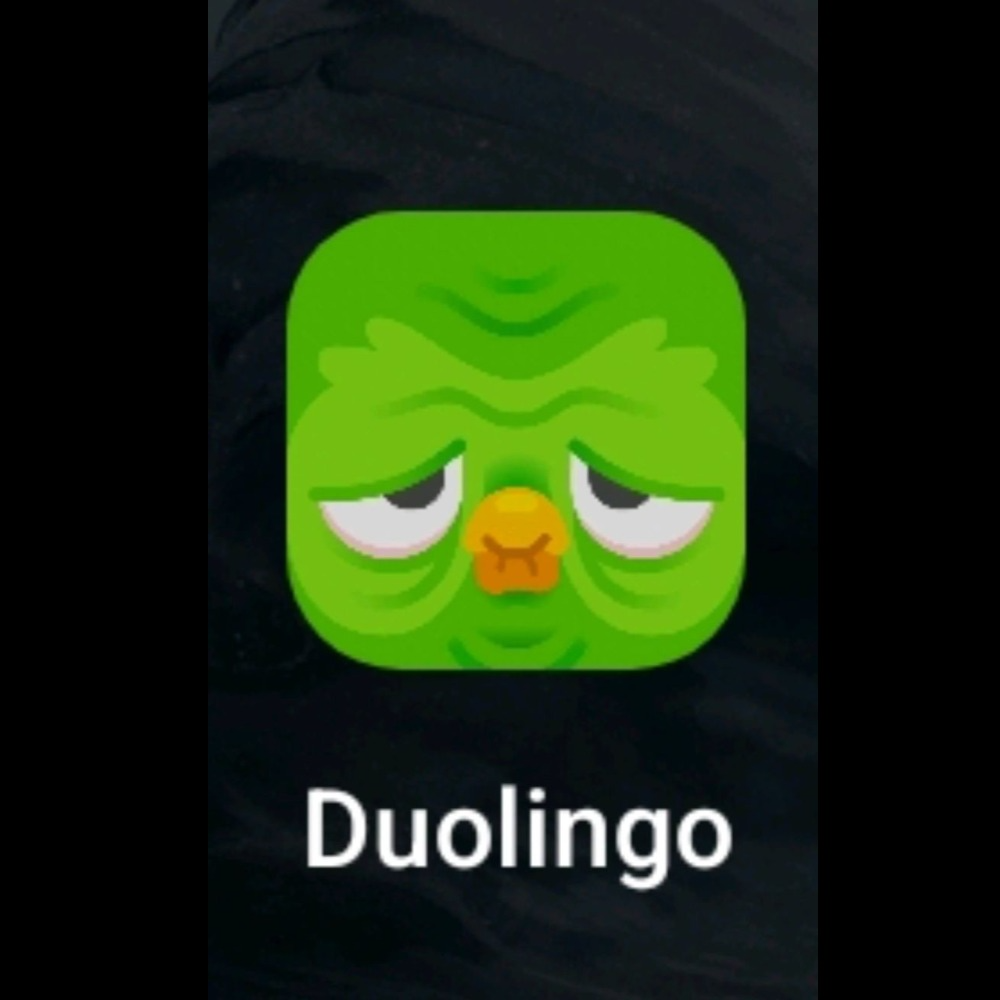
With dark circles under its eyes, a weary Duo made users chuckle in solidarity. This relatable design tapped into the universal feeling of burnout.
Sick Duo (August 2024)
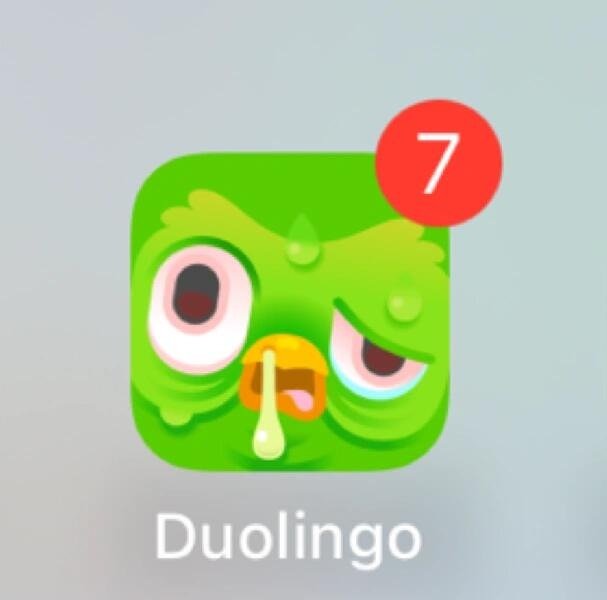
A sniffling, red-eyed Duo tugged at heartstrings with the message: "A sick Duo needs your company." This clever emotional appeal encouraged consistent learning.
Dead Duo (February 2025)
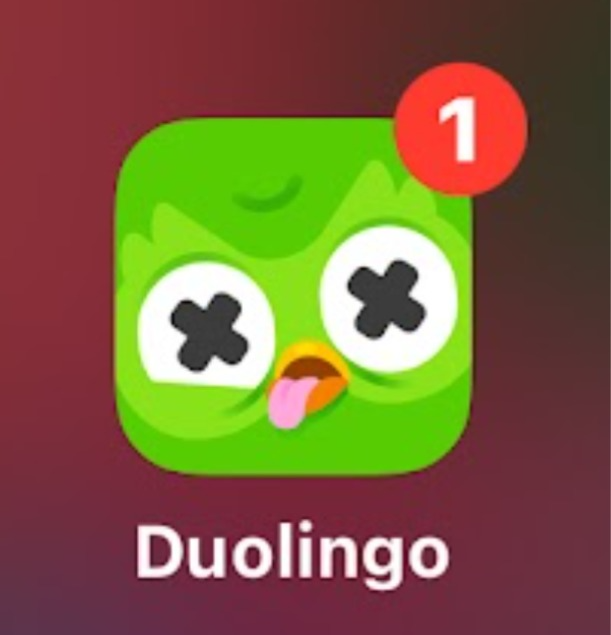
Perhaps the boldest design yet—Duo with X-ed out eyes and a dangling tongue, accompanied by the cheeky caption: "You literally killed Duo." The dark humor made learning feel unexpectedly fun.
Christmas Duo
During the holidays, Duo dons a Santa hat, sometimes surrounded by snowflakes or festive decor. The cheerful design keeps learners motivated even during celebrations.
Halloween Duo
For spooky season, Duo transforms into a ghost, witch, or pumpkin, with eerie glowing eyes—perfectly capturing the Halloween spirit.
All Of The Duolingo Characters: Lily, Zari, and the Rest of the Crew
In Duolingo's language-learning journey, the cartoon characters that pop up every now and then always bring a smile. They're not just simple interface elements; they serve as a "cheerleader squad" for users—professional yet heartwarming. Each character has a distinct personality—some are lively and energetic, others are calm and reliable, and some even bring a dose of humor. These unique personas transcend their role as mere functional tools, becoming emotional connectors that motivate users to keep learning. They add warmth and energy to the tedious vocabulary memorization and perplexing grammar exercises. Let’s take a closer look at this "cheerleader squad" and explore the charm each character brings.
Lily: The Cool Girl Who Pulls You In With Her Detachment
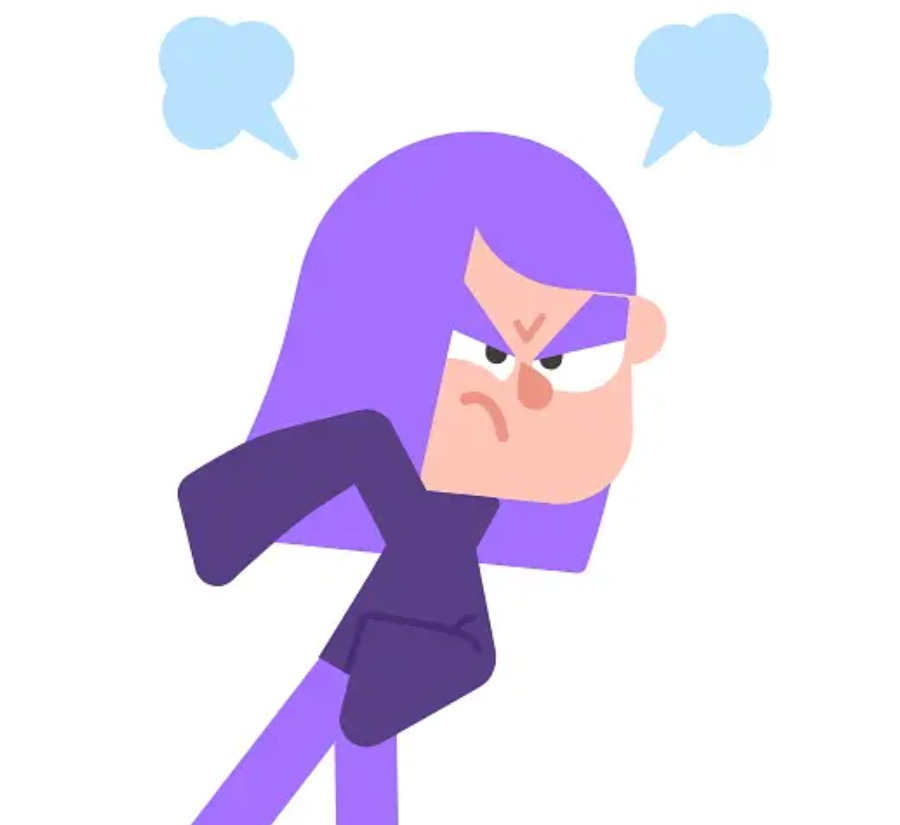
The first time you meet Lily, her "eye roll" might make you want to quit right away—white eye when you get it right, and still white eye when you get it wrong. But after spending some time with her, you’ll realize that this 16-year-old with purple hair has a certain sincerity hidden beneath her "aloofness." She doesn’t force positivity or push for motivation; instead, her laid-back phrase "Whether you do the lesson or not is up to you" gives you the space to choose. In her downtime, she enjoys indie bands and cult films, and her "non-conforming" personality makes her relatable to users who feel the same way.
Zari: The Ever-Energetic Little Sunshine
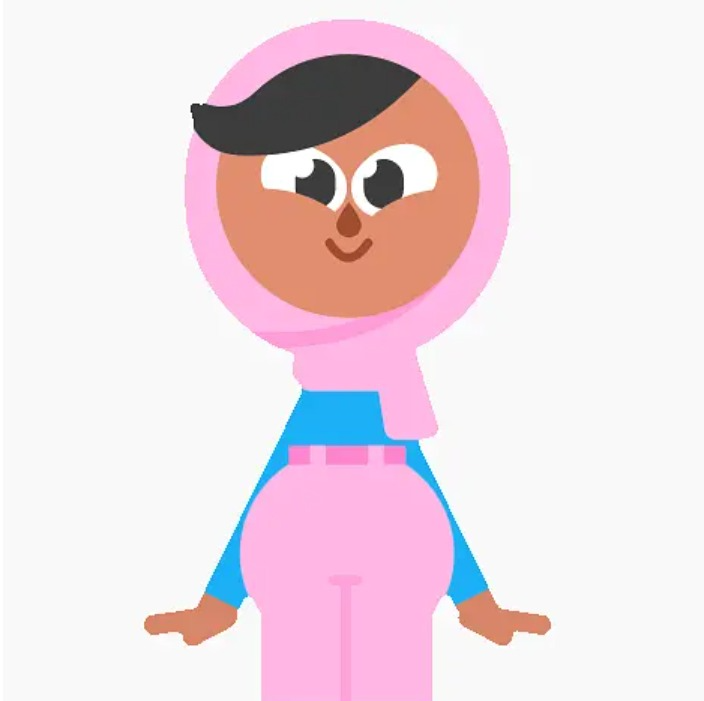
In complete contrast to Lily, Zari is like a perpetual motion machine. She’s the kind of character who gets excited about you showing up to learn. Her enthusiastic phrase, "Hello hello! Are we ready to get started?" immediately puts you in learning mode. As a community enthusiast, Zari’s relentless passion for everything (except for parrots) makes her the perfect motivator for those struggling with procrastination. After all, when you have those sparkling eyes waiting for you, it’s hard to say "no."
Bea: The Efficient Doer
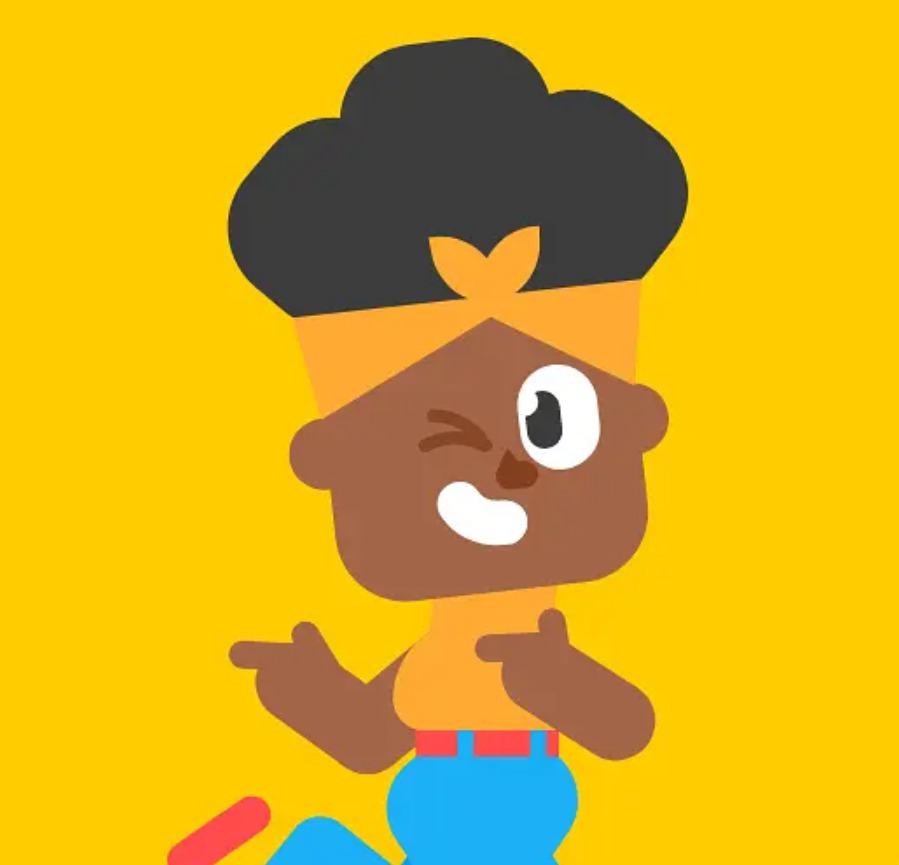
Bea has an impressive level of execution. She loves to travel and is always curious about new things, yet she has little patience for laziness. Her phrase, "Laziness is just wasting time," while blunt, always shakes you out of your procrastination. In 2021, she switched to a sharper look, saying it was to "better fit the community," which aligns perfectly with her high-efficiency, adaptable character.
Lin and Lucy: The Story-Hiding Life Enthusiasts

Lin’s "go-with-the-flow" philosophy is a hit. A part-time mechanic and motorcycle lover, she doesn’t care about others' opinions and simply says, "Sticking to the lessons is enough to be cool." Her grandmother Lucy is even more mysterious. She’s a VR aficionado, a neighborhood grandma with a "not-so-simple" aura. This pair of grandmother and granddaughter makes you realize that language learning isn’t just about passing exams—it’s about supporting a vibrant life.
Falstaff: The Chill, Lazy Bear Who Pretends to Care

This scarf-wrapped giant bear always wears a standard fake smile, and his encouraging words drip with a sense of "don’t care": "Not bad, but that’s none of my business." Falstaff feels like a mascot reluctantly dragged into the role of a cheerleader. His primary occupation is eating and napping, and his occasional role in motivation makes you feel relaxed, as though he’s saying, "It’s okay if you don’t learn, don’t put too much pressure on yourself." This laid-back attitude appeals to users who can’t stand being preached to.
Oscar: The Artistic Type With an Elegance Buff

As an art teacher, Oscar brings a touch of elegance to his encouragement. The way he holds a coffee cup while nodding in approval, or saying "Dear, you have a natural gift for languages," is both gentle and sincere. It’s said that he’s as picky about coffee as he is about art, able to distinguish between an Americano and an Australian flat white. This exquisite attention to detail adds a bit of artistic flair to language learning.
Vikram: The Healing Type Who Teaches Through Baking
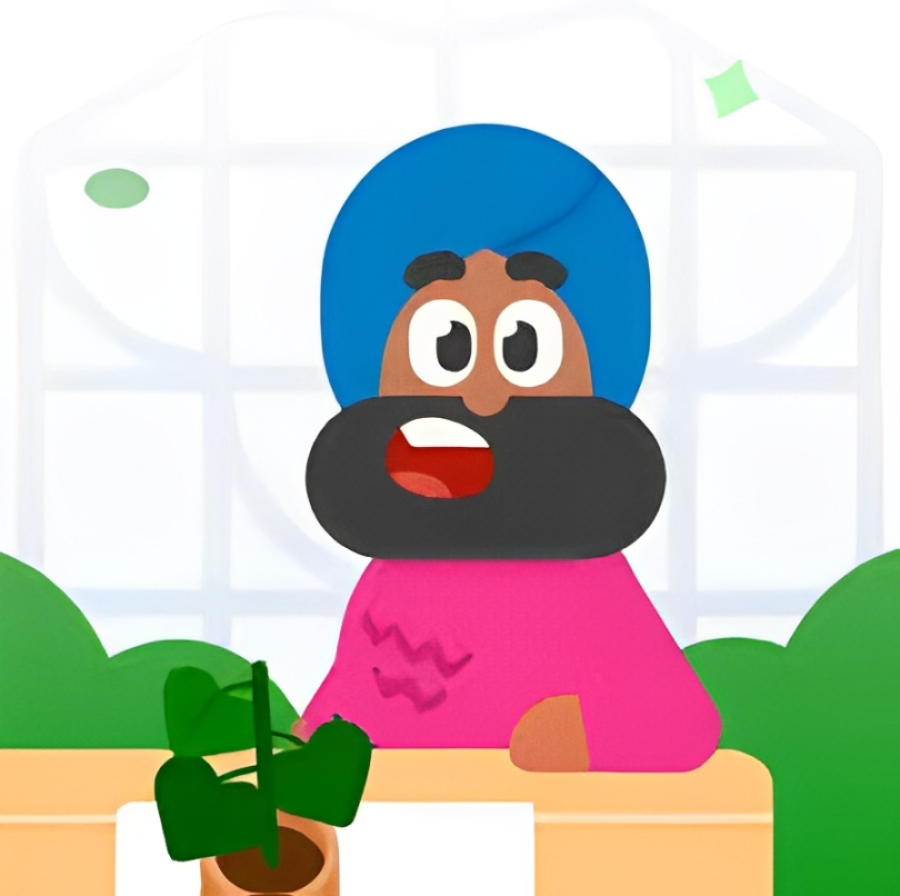
Vikram, who gave up a finance career to pursue his dream in baking, exudes warmth. He often compares learning to kneading dough: "Take your time and knead slowly, and eventually, it’ll rise." His simple metaphors hide life wisdom. As a vegetarian, he occasionally mentions his interactions with his wife, Preeti, bringing a sense of calm everyday happiness. This makes learning feel like baking—a slow, rewarding process with sweet results.
Eddy and Junior: The Father-Son Duo Full of Passion and Relatability
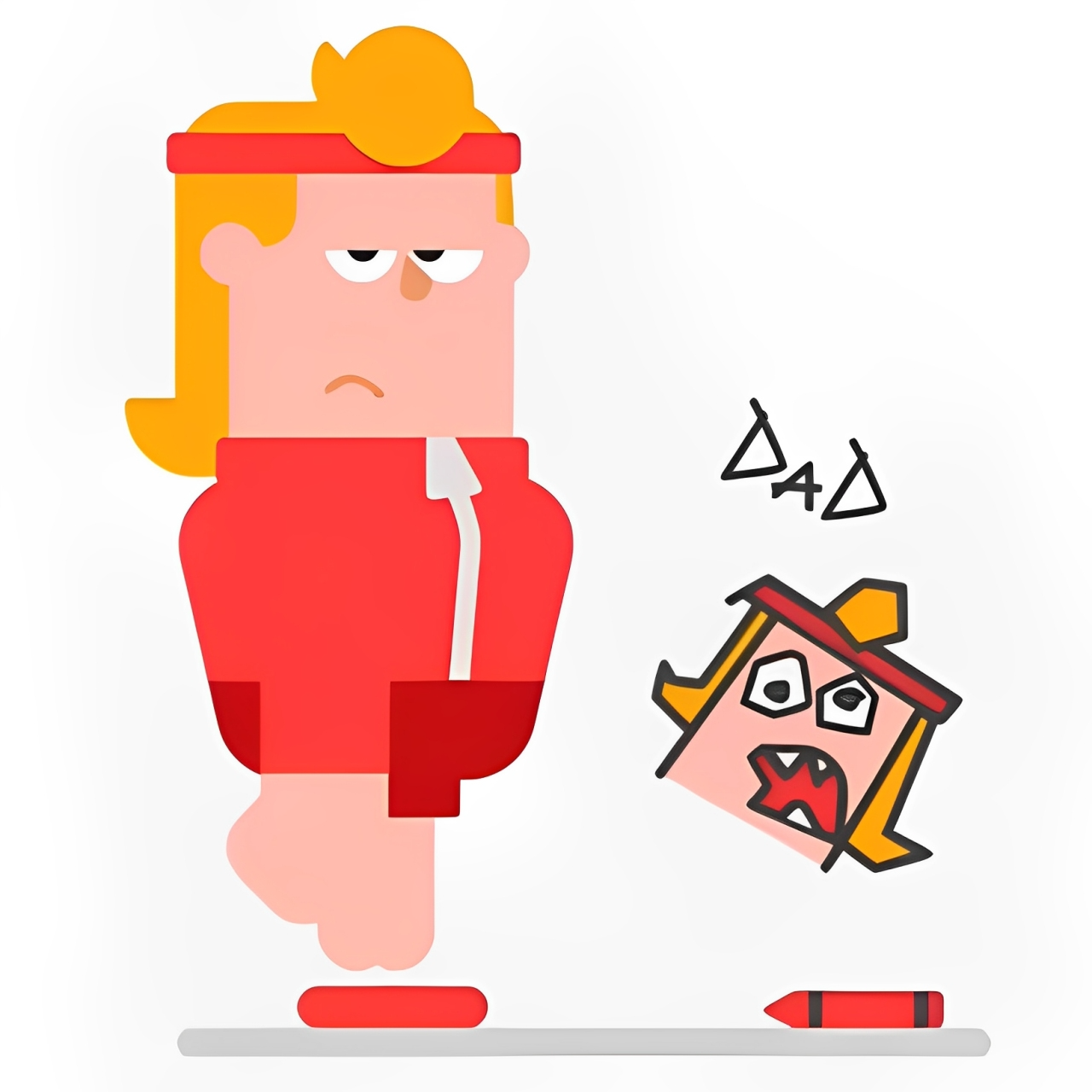
Eddy is the typical sports dad. A soccer coach, he encourages you with the same intensity he would use during a game: "Hey, how about challenging yourself with something harder?" But then he turns around and humorously adds, "Dating is just not as interesting as watching sitcoms." His son, Junior, is a cheeky little guy who’s allergic to homework but cares deeply about Lily’s matters. He sweetly urges you to get your lessons done: "Hurry up so we can play games!" This father-son duo balances each other perfectly—one pushes you to act, and the other makes learning feel as natural as family bonding.
Funniest Duolingo Memes and Jokes
If you've been scrolling through social media lately, you've definitely come across the ominous green owl—Duo. Whether it's holding a knife to urge you to study languages, "coming back from the dead" to perform some art, Duo is everywhere. When users joke about being "chased by Duolingo" for procrastinating, or mimic the app's anthropomorphized dialogues, they’ve actually transitioned from passive learners to co-creators of culture. This back-and-forth banter between users and the brand has turned Duolingo into a form of social currency among young people, gaining global attention through its "crazy marketing" and "abstract memes." Let’s dive into the origins of these viral memes and see how this bird made users both love and hate it worldwide.
“Are you seriously not studying?” — Duo’s "Gangster" Persona
Duolingo’s core meme revolves around Duo's "study-enforcer persona." Unlike other learning apps that offer gentle encouragement, Duo takes a more “gangster” approach:
“I know where you live”: If users don’t complete their lessons, Duo sends a threatening notification saying "Are you seriously not studying?" Some even Photoshop Duo into a gangster boss holding a gun, showing up at your door.

“Midnight Horror”: If you’ve procrastinated until 11:50 PM, Duo’s app icon goes from cute to "death stare" and might even "crack open."
"Duolingo isn’t a learning app, it’s an electronic debt collector": Reminders like “You haven’t finished your Spanish practice today” are paired with Duo’s cold, knife-holding expression, which users turn into countless jokes like: “I’m not learning a language, I’m avoiding the wrath of the green bird.”
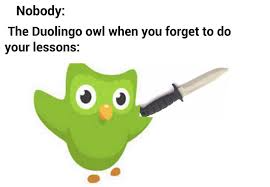
This "crazy" style actually keeps users hooked—“Being urged by Duo is more thrilling than getting pressured by my boss for KPIs.”
The "Death" of Duo: The Most Abstract Marketing Event of 2025
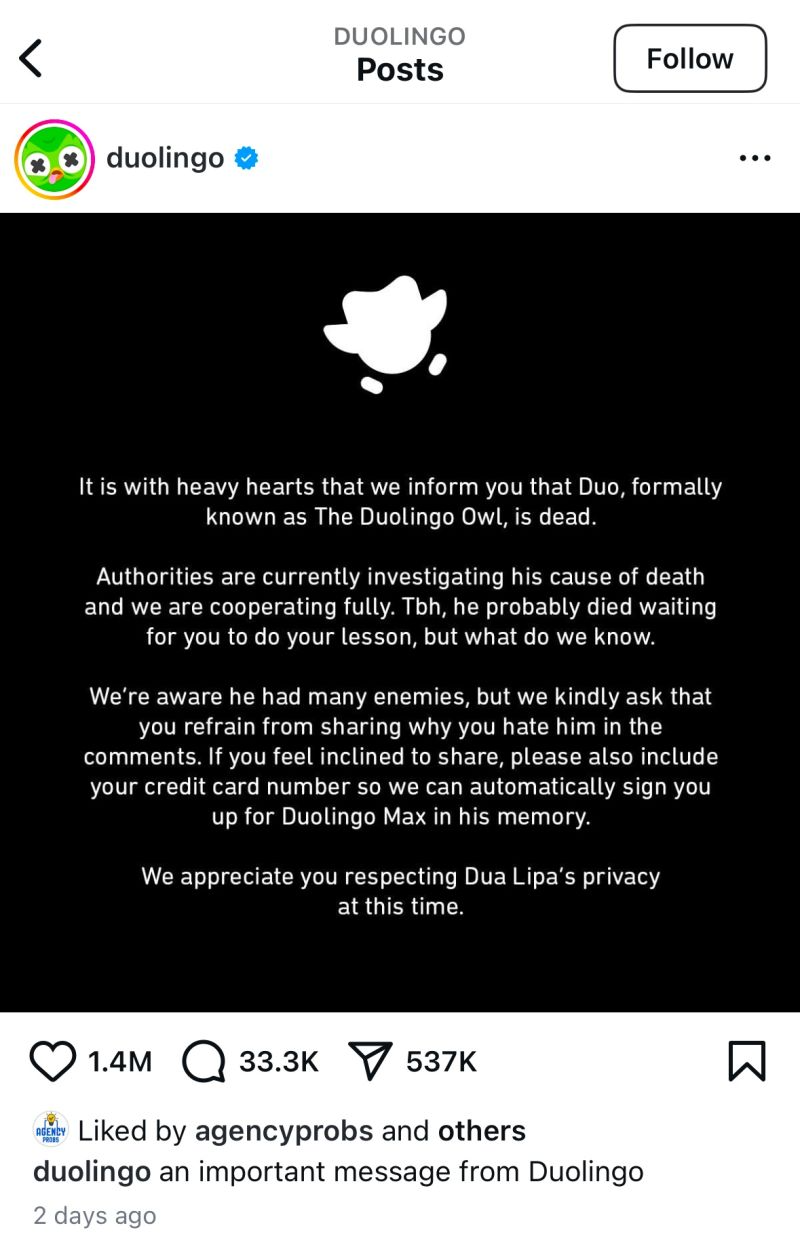
In February this year, Duolingo officially announced that "Duo is dead" and even posted an obituary saying, "It might have died waiting for you to start your lesson." The internet exploded:
- Gaming companies joined the fun: Xbox, Blizzard, and Ubisoft all posted memes "claiming responsibility," with Assassin's Creed even having the protagonist Ezio take a photo with Duo’s "corpse."
- Users mourned: Some shared their lesson records and confessed, "I killed Duo," while others photoshopped Duo being run over by a Tesla.
- "Revival Challenge": Duolingo launched a global challenge to "revive Duo by reaching 50 billion experience points," successfully bringing dormant users back to the app.
This "death marketing" was textbook-level brilliance—Duo proved that even in death, it would still force you to study.
"Duolingo Jokes": AI-Generated Absurd Literature
Duolingo’s courses are often filled with bizarre sentences that leave users wide-eyed, and these have been compiled into the "Duolingo Joke Collection":
- While learning French: "I am a croissant, are you a horse?"
- Practicing Japanese: "The cat is eating the computer, the dog is reading the newspaper."
- Studying Korean: "The pig has no money." (???)
- Learning Cantonese: "I want pork chop with black bean sauce, please." (The only sentence I know in a Chinese restaurant.)
These absurd sentences are so addictive that users joke, "Duolingo isn’t teaching languages, it’s teaching abstract literature."
Official Plays Along: Turning Memes into Brand Social Currency
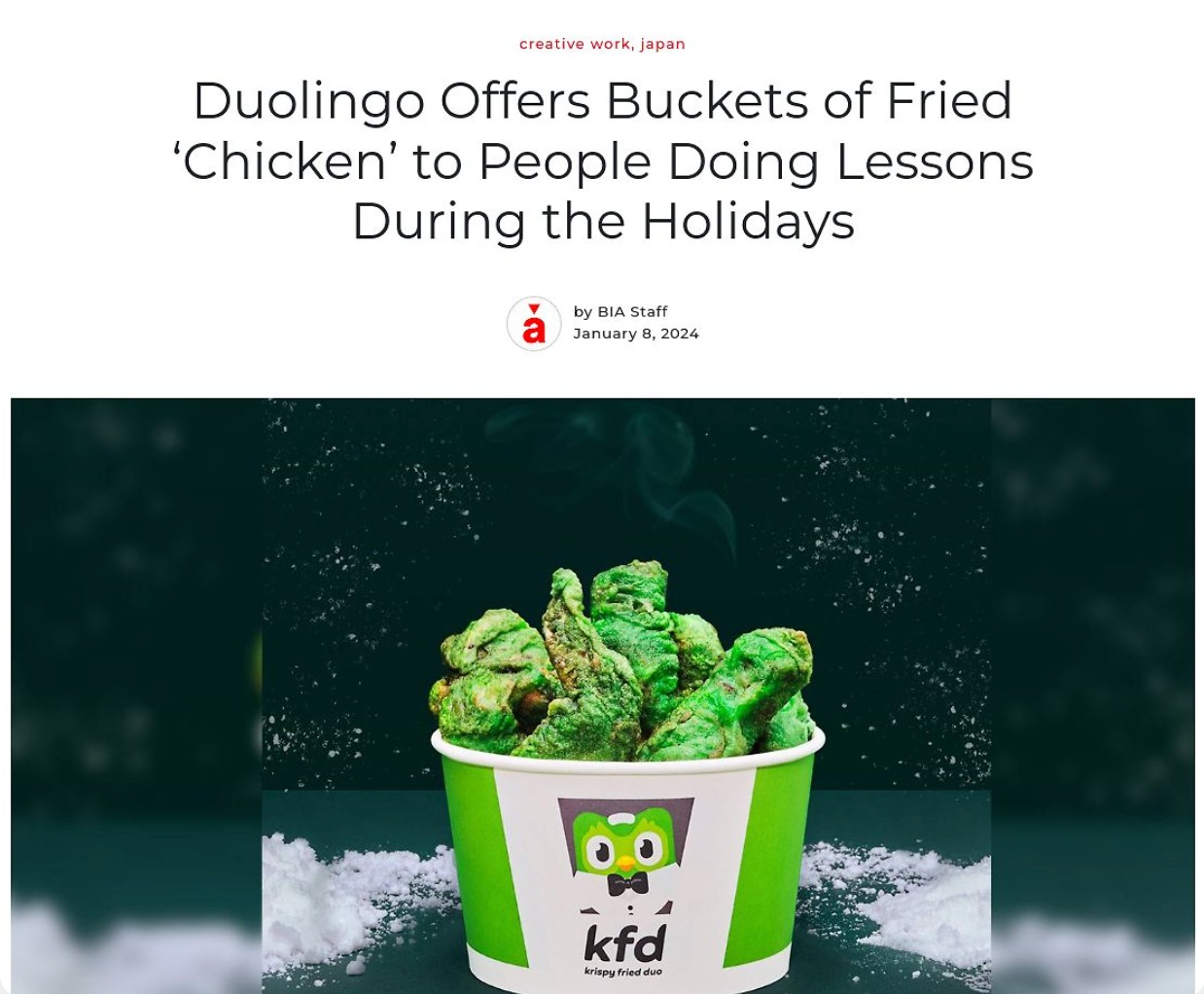
In Japan, Duolingo launched the "KFD (Krispy Fried Duo)" campaign, turning Duo into a green fried chicken meal with the tagline, "Don’t study today? Then we’ll eat you." This move sent the internet into a frenzy: "The official account understands how to roast Duo better than we do" and "Now if we don’t learn languages, even the mascot gets fried?"
Similar "self-deprecating" marketing stunts include Halloween posters with Duo holding a pumpkin threatening users, and a Christmas short where Duo steals your gifts if you don’t learn a language. By embracing the memes, Duolingo not only reinforced brand recognition but also made users feel like "this app is one of us."
How to Use Duolingo More Effectively?
At 1 AM, you're lying in bed scrolling through your phone when suddenly a push notification pops up—“Your French streak is about to end!” The familiar green owl (Duo) is staring at you with a death glare, as if saying, “If you don’t study today, tomorrow your French will be back to the 'Bonjour' level.”
You sigh, open Duolingo, and think to yourself: “Is this app really useful? Is the free version enough? Is it worth getting a subscription?”
As a user who started learning French from scratch on Duolingo and has kept up my 600-day streak thanks to "Duo's" relentless nudging, I’d like to share how to use Duolingo effectively, and compare the free version with the subscription version.
Duolingo's Core Logic for Learning Languages: Why Does It Keep You Going?
The biggest difference between Duolingo and other language learning apps is that it turns learning into "gamified tasks":
- Instant Feedback: Every time you complete a small exercise, you immediately get a "ding" sound and experience points, which releases dopamine in your brain and makes you addicted.
- Forgetting Prevention System: The AI arranges reviews of old knowledge based on your memory curve, preventing the "learn it and forget it" cycle.
- Social Competition: The leaderboard pits you against users worldwide, triggering a "I can't lose" mentality.
But here’s the catch:
- The free version has heart limits, so if you make five mistakes, you have to wait for them to regenerate, which interrupts your learning flow.
- The review content is random, so you might end up repeating things you already know while your weak spots get overlooked.
- You can't skip over easy content, wasting time on basic sentences like "The apple is red."
This is where the subscription version (Super Duolingo) stands out—it’s not just about “removing ads” but making learning more efficient and less painful.
Free Version vs. Subscription: What's the Real Difference?
1. Free Version: You Can Learn, But It Requires Patience
Pros:
- All core lessons are free, from "hello" to "does this horse drink milk?"
- No ads interrupting your learning (unlike some apps with pop-ups).
- Gamification (streaks, leaderboards) still works.
Pain Points:
- Heart Limit (5 hearts): Get one wrong answer and you lose a heart. Once you run out of hearts, you either have to wait for them to regenerate or do boring review exercises to "heal" 10 hearts.
- No Skipping Levels: Even if you’ve already mastered “Je m'appelle...,” you still have to slog through it.
- Non-smart Review: You may keep practicing simple sentences like "The cat eats fish" while skipping over more challenging grammar like the subjunctive.
Best For:
- People on a budget who want to try it out.
- Highly self-disciplined individuals who can handle slow-paced learning.
- Casual users who only want to study for 5-10 minutes a day.
2. Subscription (Super Duolingo): An Enhanced Learning Experience
Pros:
- Unlimited Hearts: You can make mistakes without worrying about "Game Over," which is perfect for tackling harder content.
- Smart Review: The AI pinpoints your weak areas, preventing useless repetition.
- Skip Levels: Skip past content you already know, saving time.
- Offline Learning: You can study even when you’re commuting or have a bad internet connection.
Cons:
Expensive: Duolingo’s pricing varies by region. For example, in the U.S.:
- Monthly subscription: $8.17 - $9.58 per month
- Annual subscription: $51.83 - $58.87 per year
- Family plan: $88.45 - $96.90 per year (up to 6 users, about $14.74 - $16.15 per person per year)
Can Encourage "Lazy" Studying: Since there’s no penalty for mistakes, some users might rush through lessons without fully understanding them.
Best For:
- Long-term learners (e.g., preparing for study abroad or work).
- Users who easily give up (the heart limit frustration can be reduced with a subscription).
- Efficiency-focused learners (those who want to maximize their learning in the shortest time).
My Real Experience: Does the Subscription Really Help You Learn Faster?
I’ve tried using the free version for 100 days and also had a 3-month subscription. Here’s what I found:
- The free version works, but it really tests your patience. The heart limit drove me crazy when learning French verb conjugations, but being forced to review helped me remember better.
- The subscription version is smoother, but it made me a little "lazy." Because I could skip ahead, I sometimes avoided the harder parts, leading to gaps in my grammar knowledge.
Best Strategy?
- Start with the free version: If you can stick with it for 30 days, then consider getting a subscription.
- Subscription + External Supplements: Use the subscription version and supplement it with grammar books or language partners to avoid relying only on the app.
Conclusion: It’s All About How You Use It
Duolingo’s subscription isn’t a "magic hack" for language learning—it just makes things smoother. If you:
- Lack self-discipline → The subscription reduces the chances of giving up.
- Have limited time → The subscription helps you avoid wasting time on unnecessary exercises.
- Want to learn fast → Combine the subscription with additional input (like podcasts or watching shows) for better results.
But if you're just casually learning, the free version is more than enough. After all, what really helps you learn a language isn’t the subscription, but your persistence.
How to Use Duolingo Membership Plans Most Cost-Effectively
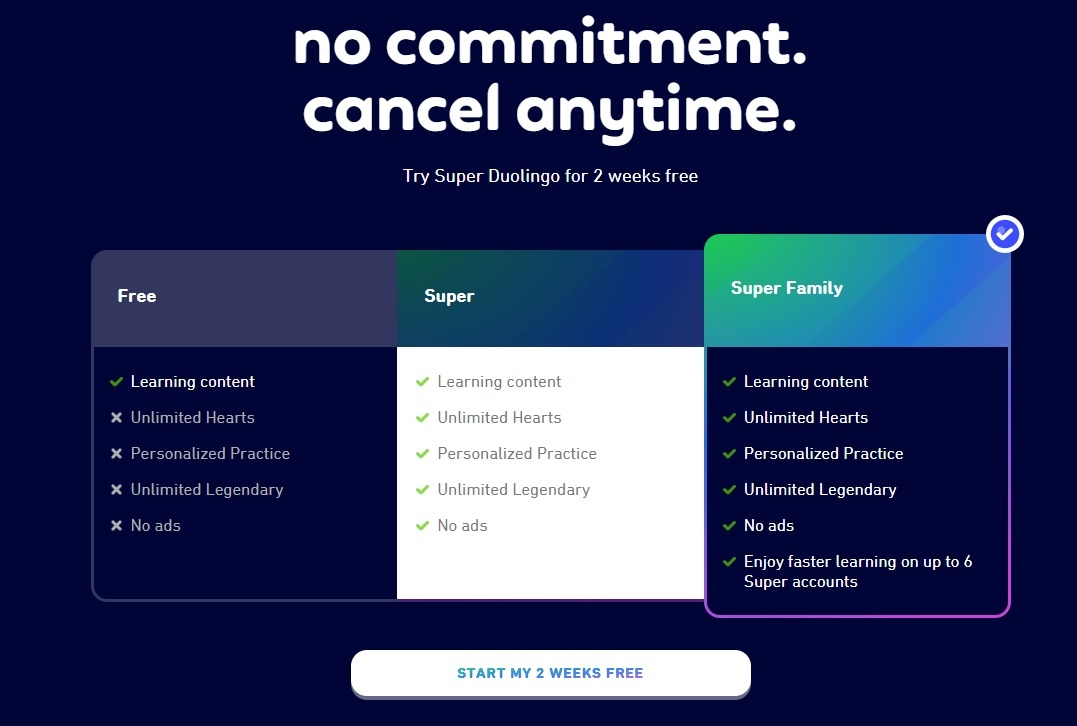
Last year, I planned to learn Spanish and thought about subscribing to Duolingo’s membership to unlock unlimited practice and offline learning features. But when I saw the price, I realized that purchasing an individual membership wasn’t cost-effective. I considered using the family plan to split the cost but didn’t have friends to team up with. Then, I discovered a money-saving trick for Duolingo’s family plan, where you can get it for just $9.99 per year without needing to group up with friends. If you’re learning a language with family or friends, the family plan is a great option for mutual accountability, but if you can’t find a group, I highly recommend trying this money-saving trick.
| Dimension | Super Plan (Monthly Subscription) | Super Plan (Annual Subscription) | Super Family Plan | Super Family Plan (FamilyPro Platform) |
|---|---|---|---|---|
| Number of Users | 1 user | 1 user | Supports up to 6 users | Can be used by 1 user without needing to group up |
| Main Features | - Unlimited hearts- Smart review- Skip levels- Offline learning- Ad-free | - Unlimited hearts- Smart review- Skip levels- Offline learning- Ad-free | - All features of Super Plan- Supports multiple users | - All features of Super Plan- Supports multiple users |
| Pricing (US Region) | Monthly Subscription: $8.17 - $9.58/month | Annual Subscription: $51.83 - $58.87/year | Annual Subscription: $88.45 - $96.90/year | / |
| Annual Cost per User | - | $51.83 - $58.87/year | $14.74 - $16.15 per user per year | $9.99/year |
| Monthly Cost per User | $8.17 - $9.58/month | $4.32 - $4.91/month (Annual subscription divided by 12 months) | $1.23 - $1.35 per user per month (Based on 6 users) | $0.83/month |
| Suitable for | Individual users, users with a limited budget | Individual users, long-term learners | Family or group users | Individual users, long-term learners |
| Value | - | If you plan to use it long-term, the annual subscription is more cost-effective | If there are multiple users, the family plan offers better value | No need to group up to buy the family plan, enjoy the same membership services |
Better Value Compared to Personal Membership
The main advantage of the family plan over the personal Super membership (Super Individual) is the cost-effectiveness. The family plan allows up to 6 users to share one Plus subscription. Everyone can enjoy premium benefits like ad-free learning, offline access, and personalized review, which significantly reduces the cost per person compared to buying an individual subscription. Some of my friends and classmates joined together to get the family plan. Initially, they thought the personal membership was a bit expensive, but when the cost was shared, everyone could easily access the membership features and supervise each other’s learning, making it a win-win.
Flexible Management for Different Learning Scenarios
This plan is particularly flexible. The main account holder can easily manage the subscription, adding or removing users without much hassle. Whether it's a family of language enthusiasts wanting to each learn different languages or a group of friends committing to mastering the same foreign language, the family plan can meet all these needs. This allows everyone to enjoy high-quality language learning resources without going over budget.
Pro Tip: Get the Discount Even Without a Group
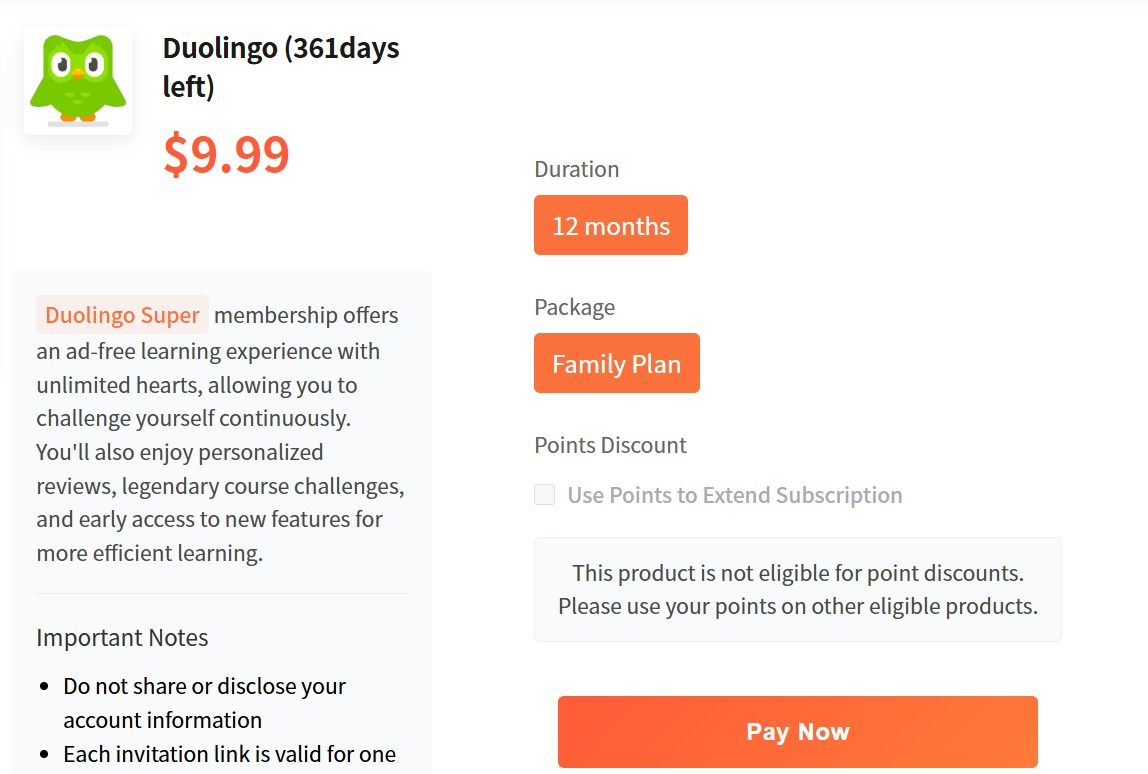
If you haven’t found family or friends to join yet, you can join someone else’s family group through platforms like FamilyPro . This way, you can still enjoy the full membership benefits at a better-than-family-plan price, which is a smart money-saving trick.
Common Issues with Duolingo Icon
Why does my Duolingo icon look "cracked," "melting," or "sick"?
The "cracked" Duolingo icon is usually part of an official marketing campaign, not a technical issue. If it's an official event, there’s no need to fix it—just wait for the official update.
What should I do if my Duolingo icon appears incorrectly (blank, blurry, or wrong)?
If the icon issue is not part of an official campaign, it may be caused by one of the following reasons:
System Icon Cache Error
- For Android: Go to "Settings" → "App Management" → "Duolingo" → "Storage" → "Clear Cache."
- For iOS: Restart your device or uninstall and reinstall the app.
App Not Updated
Check the app store (App Store / Google Play) to ensure your Duolingo app is updated to the latest version.
System Compatibility Issues
Some older systems may not be compatible with the latest version of Duolingo. Try updating or downgrading your system.
Third-Party Theme/Desktop Software Conflict
If you're using third-party launchers like Nova Launcher, try switching back to the default theme or resetting the icon pack.
Virus Infection or File Corruption
Use antivirus software to scan your device and reinstall Duolingo.
How can I change my Duolingo icon?
Duolingo supports personalized icon changes (available for some users only):
- For iOS: Open the app → tap the "Streak" icon → select "New App Icon."
- For Android: Some devices allow you to change icons in "Settings" → "Themes and Icons," or you can use third-party launchers like Nova Launcher.
Will Duolingo icon issues affect my learning data?
Typically, no. Icon display issues usually do not affect your course progress or account data.
Conclusion: Why does my Duolingo icon look sick?
At the end of the day, the seemingly “gloomy” changes to Duolingo’s icons are just clever tricks this owl has spent ten years perfecting. From drooping eyelids to a "cracked" body, every expression subtly brings it closer to the learner. It’s not a cold, impersonal learning tool; rather, it’s a partner that throws tantrums and pouts, pushing you forward in the most human way possible.
This brilliance in making the tool “come alive” isn’t just reflected in Duo. Lily’s eye-roll hides her playful side, while Zari’s enthusiasm wraps around her encouragement. These vibrant personalities work together to transform language learning from a monotonous task into an interactive and fun conversation. Perhaps it’s this “humanized” warmth that makes opening the app no longer feel like a burden but a habit full of anticipation.
Because of this, when choosing between the free version and the subscription, why not let these “emotion experts” set the pace for you? Start by letting Duo’s iconic “death stare” trigger your muscle memory for persistence, and when you’re sure that the journey of learning a language is worth investing in, unlock the advanced features with a subscription. After all, making progress under the guidance of your temperamental partners is far more lively than dull rote memorization. If you’re planning to subscribe, don’t forget the money-saving tip: the FamilyPro shared plan is the most cost-effective option.